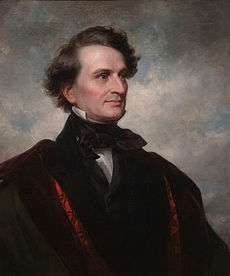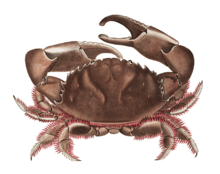James Dwight Dana
| James Dwight Dana | |
|---|---|
|
Dana in 1865 | |
| Born |
February 12, 1813 Utica, New York |
| Died |
April 14, 1895 (aged 82) New Haven, Connecticut |
| Nationality | United States |
| Fields | geology, mineralogy, zoology |
| Influences |
Benjamin Silliman Amos Eaton |
|
Signature | |
James Dwight Dana FRS FRSE (February 12, 1813 – April 14, 1895) was an American geologist, mineralogist, volcanologist, and zoologist. He made pioneering studies of mountain-building, volcanic activity, and the origin and structure of continents and oceans around the world.
Early life and career
Dana was born February 12, 1813 in Utica, New York. His father was merchant James Dana (1780–1860), and mother was Harriet Dwight (1792–1870). Through his mother he was related to the Dwight New England family of missionaries and educators including uncle Harrison Gray Otis Dwight and first cousin Henry Otis Dwight.[1] He showed an early interest in science, which had been fostered by Fay Edgerton, a teacher in the Utica high school, and in 1830 he entered Yale College in order to study under Benjamin Silliman the elder. Graduating in 1833, for the next two years he was teacher of mathematics to midshipmen in the Navy, and sailed to the Mediterranean while engaged in his duties.
In 1836 and 1837 he was assistant to Professor Silliman in the chemical laboratory at Yale, and then, for four years, acted as mineralogist and geologist of the United States Exploring Expedition, commanded by Captain Charles Wilkes, in the Pacific Ocean. His labors in preparing the reports of his explorations occupied parts of thirteen years after his return to America in 1842. His notebooks from the four years of travel contained fifty sketches, maps, and diagrams, including views of both Mount Shasta and Castle Crags. Dana's sketch of Mount Shasta was engraved in 1849 for publication in the American Journal of Science and Arts (which Silliman had founded in 1818), along with a lengthy article based on Dana's 1841 geological notes. In the article he described in scientific terms the rocks, minerals, and geology of the Shasta region. As far as is known, his sketch of Mount Shasta became the second view of the mountain ever published.
In 1844 he again became a resident of New Haven, and married Professor Silliman's daughter, Henrietta Frances Silliman. In 1850, he was appointed as Silliman's successor, as Silliman Professor of Natural History and Geology in Yale College, a position which he held until 1892. In 1846 he became joint editor, and during the later years of his life was chief editor, of the American Journal of Science and Arts, to which he was a constant contributor, principally of articles on geology and mineralogy.

The 1849 publication of his geology of Mount Shasta was undoubtedly a response to the California gold rush publicity. Dana was the pre-eminent U.S. geologist of his time, and he also was one of the few trained observers anywhere who had first hand knowledge of the northern California terrain. He had previously written that there was likelihood that gold was to be found all along the route between the Umpqua River in Oregon and the Sacramento Valley. He was probably deluged with inquiries about the Shasta region, and was forced to publish in more detail some advice to the would-be gold miners.
Dana was responsible for developing much of the early knowledge on Hawaiian volcanism. In 1880 and 1881 he led the first geological study of the volcanics of Hawaii island. Dana theorized that the volcanic chain consisted of two volcanic strands, dubbed the "Loa" and "Kea" trends. The Kea trend included Kīlauea, Mauna Kea, Kohala, Haleakala, and West Maui. The Loa trend includes Lōʻihi, Mauna Loa, Hualālai, Kahoʻolawe, Lānaʻi, and West Molokaʻi.
Following another expedition by fellow geologist C. E. Dutton in 1884, Dana returned to the island once again and in 1890 he published a manuscript on the island that was the most detailed of its day, and would be the definitive source upon the island's volcanics for decades.
Dana died on April 14, 1895.
Family
Dana was married to Henrietta Silliman in 1844.[2]
Their son, Edward Salisbury Dana (1849–1935), was also a distinguished mineralogist.
Publications

Dana's best known books were his
- System of Mineralogy (1837)
- Manual of Mineralogy (1848),[3] and his Manual of Geology (1863).[4] A bibliographical list of his writings shows 214 titles of books and papers, beginning in 1835 with a paper on the conditions of Vesuvius in 1834. His reports on Zoophytes, on the Geology of the Pacific Area, and on Crustacea, summarizing his work on the Wilkes Expedition, appeared from 1846 onwards. Other works included Manual of Mineralogy (1848), afterwards entitled Manual of Mineralogy and Lithology (ed. 4, 1887); and Corals and Coral Islands] (1872; revised ed. 1890).[5] In 1887, Dana revisited the Hawaiian Islands, and the results of his further investigations were published in a quarto volume entitled Characteristics of Volcanoes (1890).[6]
The Manual of Mineralogy by J. D. Dana became a standard college text, and has been continuously revised and updated by a succession of editors including W. E. Ford (13th-14th eds., 1912–1929), Cornelius S. Hurlbut (15th-21st eds., 1941–1999), and beginning with the 22nd by Cornelis Klein. The 23rd edition is now in print under the title Manual of Mineral Science (Manual of Mineralogy) (2007), revised by Cornelis Klein and Barbara Dutrow.
Dana's System of Mineralogy has also been revised, the 6th edition (1892)[7] being edited by his son Edward Salisbury Dana. A 7th edition was published in 1944, and the 8th edition was published in 1997 under the title Dana's New Mineralogy, edited by R. V. Gaines et al.
Between 1856 and 1857, Dana published a number of manuscripts in an effort to reconcile scientific findings with the Bible. Among these, he wrote Science and the Bible: A Review of the Six Days of Creation (1856),[8] and Creation, Or, The Biblical Cosmogony in the Light of Modern Science (1885).
Awards
Dana was awarded the Copley Medal by the Royal Society in 1877, the Wollaston Medal by the Geological Society of London in 1874 and the Clarke Medal by the Royal Society of New South Wales in 1882.
Named in honor of Dana
- Dana Park in Albany, New York, with a fountain/monument in his honor
- Mount Dana (and the nearby Dana Meadows) in the Sierra Nevada, California, US
- Dorsa Dana (a wrinkle-ridge system) on the Moon
- Danalite, a mineral.
- Dana Passage in Puget Sound, US
- Dana, a crater on Mars
- The Dana Medal of the Mineralogical Society of America was named for Dana and his son Edward Salisbury Dana. It recognizes outstanding scientific contributions through research in the mineralogical sciences by an individual in the midst of their career.
- The James Dwight Dana House in New Haven, Connecticut was declared a National Historic Landmark in 1965.
- The fossil horseshoe crab Euproops danae
See also
- European and American voyages of scientific exploration
- Timeline of the discovery and classification of minerals#The System of Mineralogy of James D. Dana
Notes
- ↑ Benjamin Woodbridge Dwight (1874). The history of the descendants of John Dwight, of Dedham, Mass. 2. J. F. Trow & son, printers and bookbinders. pp. 795–799.
- ↑ https://www.royalsoced.org.uk/cms/files/fellows/biographical_index/fells_indexp1.pdf
- ↑ James Dwight Dana; William Ebenezer Ford (1915). Dana's Manual of Mineralogy for the Student of Elementary Mineralogy, the Mining Engineer, the Geologist, the Prospector, the Collector, Etc. (13 ed.). John Wiley & Sons, Inc. pp. 299–300. Retrieved 2009-07-06.
- ↑ James Dwight Dana (1880). Manual of geology: Treating of the Principles of the Science with Special Reference to American geological history, for the use of colleges, academies, and schools of science (3 ed.). New York: Ivison, Blakeman, Taylor and Co. Retrieved 2009-07-06.
- ↑ James Dwight Dana (1875). Corals and coral islands (2 ed.). London, UK: Sampson Low, Marston, Low and Searle. Retrieved 2009-07-06.
- ↑ James Dwight Dana (1891). Characteristics of volcanoes : with contributions of facts and principles from the Hawaiian Islands. New York: Dodd, Mead and Co. Retrieved 2009-07-06.
- ↑ Edward Salisbury Dana (1911). The system of mineralogy of James Dwight Dana (2 ed.). New York: J. Wiley & Sons. Retrieved 2009-07-06.
- ↑ James Dwight Dana (1856). Science and the Bible: a review of "the six days of creation" of Prof. Taylor Lewis. Andover: Warren F. Draper. Retrieved 2009-07-06.
References
 This article incorporates text from a publication now in the public domain: Chisholm, Hugh, ed. (1911). "Dana, James Dwight". Encyclopædia Britannica (11th ed.). Cambridge University Press.
This article incorporates text from a publication now in the public domain: Chisholm, Hugh, ed. (1911). "Dana, James Dwight". Encyclopædia Britannica (11th ed.). Cambridge University Press.- American Mineralogist, Vol. 21 (1936), 173-177
Further reading
- *The Life of James Dwight Dana: Scientific Explorer, Mineralogist, Geologist, Zoologist, Professor in Yale University, Daniel Coit Gilman, Harper & Brothers Publishers, New York, 1899
- Artikel James Dwight Dana in der Encyclopædia Britannica von 1911. Gemeinfrei.
- David R. Oldroyd (1996): Thinking about the Earth, Harvard Press, ISBN 0-674-88382-9; dt.: Die Biographie der Erde. Zur Wissenschaftsgeschichte der Geologie, Frankfurt a.M., 1998.
- Johannes Uray, Chemische Theorie und mineralogische Klassifikationssysteme von der chemischen Revolution bis zur Mitte des 19. Jahrhunderts. In: Berhard Hubmann, Elmar Schübl, Johannes Seidl (eds.), Die Anfänge geologischer Forschung in Österreich. Beiträge zur Tagung „10 Jahre Arbeitsgruppe Geschichte der Erdwissenschaften Österreichs“ von 24. bis 26. April 2009 in Graz. Graz 2010, S 107-125.
- Stanton, William (1970–80). "Dana, James Dwight". Dictionary of Scientific Biography. 3. New York: Charles Scribner's Sons. pp. 549–554. ISBN 978-0-684-10114-9.
External links
-
 Works written by or about James Dwight Dana at Wikisource
Works written by or about James Dwight Dana at Wikisource
| Wikimedia Commons has media related to James Dwight Dana. |
| Wikiquote has quotations related to: James Dwight Dana |
 "Dana, James Dwight". Appletons' Cyclopædia of American Biography. 1900.
"Dana, James Dwight". Appletons' Cyclopædia of American Biography. 1900.- National Academy of Sciences Biographical Memoir
| Awards and achievements | ||
|---|---|---|
| Preceded by Frederick McCoy |
Clarke Medal 1882 |
Succeeded by Ferdinand von Mueller |
